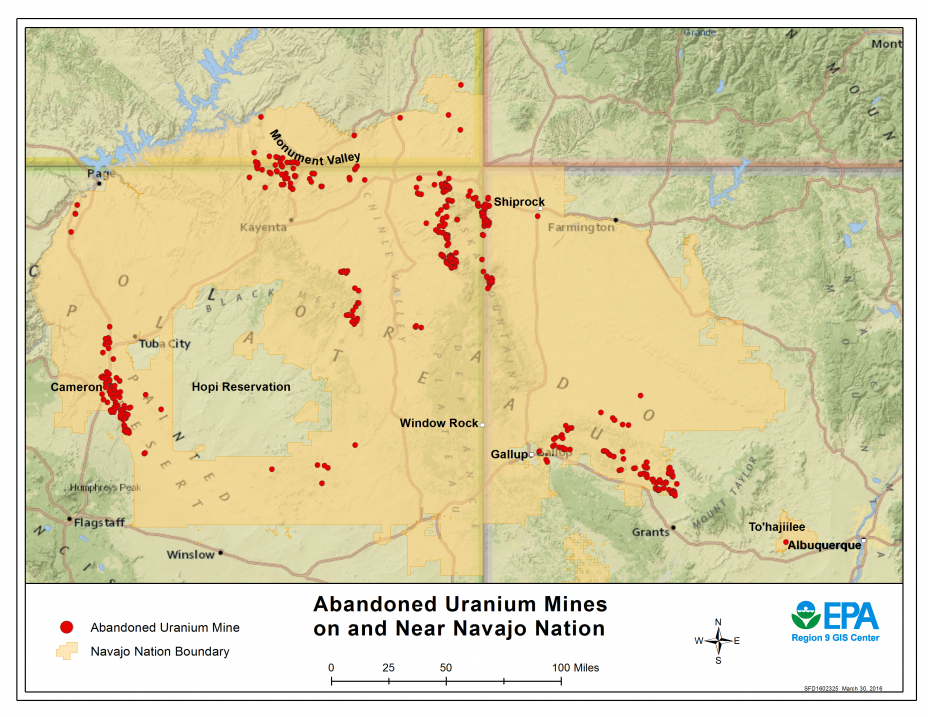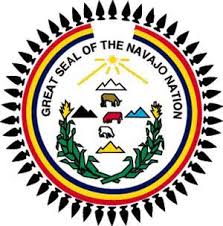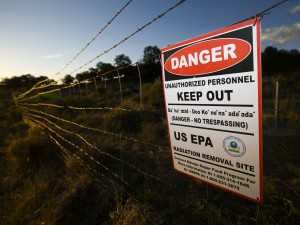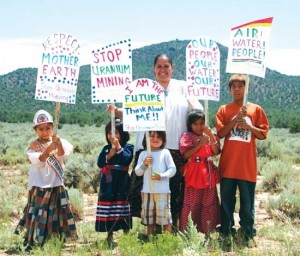In 1948, the U.S. Atomic Energy Commission issued a statement that it would purchase all mined uranium for the cause of developing nuclear weapons. Mining companies flocked to Navajo Nation, employing about 3,000 Navajo men. Workers were only paid an hourly wage of about $0.81 to $1.00 in 1949, yet many families initially viewed uranium mining as an employment opportunity.[1] However, obvious costs soon outweighed the benefits, and the environmental injustices committed within Navajo Nation still remain unresolved today.

https://www.epa.gov/navajo-nation-uranium-cleanup
Unethical Practices
In 1950, the U.S. Public Health Service (PHS) conducted research on health hazards and acknowledged Navajo workers were exposed to levels of radon high enough to cause cancer. While many Navajo people suspected that the dramatic increase in lung cancer mortalities were due to unsafe conditions in uranium mines, they did not have the scientific education to understand the lethal effects of uranium. In fact, the word “uranium” did not even exist in the Navajo language. The PHS did not follow through in establishing proper ventilation standards and kept the results of the study unpublished in order to avoid causing worker strikes. The ethical violations of the 1950 study are apparent in the way that informed consent, or the communication of risks and hazards to the experimental participants – the workers, was not practiced[2]. Therefore, the federal government clearly had knowledge of the lethal health affects, but did not take any action to decrease miner mortality.
Political Economic Framework
The exploitation of Navajo wage labor for the profit and prosperity of several mine company owners clearly demonstrates how the Navajo people were incorporated into the capitalist cycle of production. According to Robbins, Hintz, and Moore, “a tragic combination of high profits and bureaucratic inertia allowed for terrible mine conditions” (215).[3] Capitalists, or mine company owners, generated more profit by paying workers less than the true value of their labor. In the cycle, this extra revenue was necessary for operating costs and expanding the corporate monopoly. The capitalist system eventually exploits all readily available environmental resources or must sacrifice non-labor values for the sake of high profits. Environmental degradation, or radioactive contamination, results, posing further challenges to mining companies.[4] Because reservations are sovereign, government regulations to keep mining practices in-check are lax. Analyzing the issue through a political economic framework reveals that mining threatens the health and physical environment of targeted individuals. Therefore, the degradation of sacred land is synonymous with the destruction of Navajo cultural identity.
Upholding Sovereignty
Multiple lawsuits against mining corporations and the federal government proved ineffective, as the government repeatedly cited mining interests as necessary for fulfilling national security. The efforts of these grassroots organizations eventually culminated in the passage of Radiation Exposure Compensation Act (RECA) in 1990, a law finally designed to compensate Navajo workers.[5]
Although Navajo Nation has made significant progress in seeking environmental justice, there is still much more growth necessary for the complete revitalization of Navajo culture. RECA was insufficient in its compensation to many miners, and still today, the Navajo people are struggling to ward off advances from the uranium industry. The renewed interest of mining on Navajo lands can be traced to Vice President Richard Cheney’s 2001 energy task force that prioritized the expansion of nuclear power. Mining companies campaigned for support using the lure of jobs, a drawing factor for the impoverished citizens of many New Mexican reservation towns. Hostility emerged on the side of pro-mining interests, who claimed that the Navajo were seizing public land for themselves[6], further alienating and victimizing the Navajo people.
Overall, Navajo land has not been restored to the fully habitable state prior to radioactive contamination. 409 mines have radiation levels more than twice the background level, which continues to pose a threat to people’s health.[7] Although the government has played somewhat of a role in remediation efforts, much action is still necessary to block industry advances and alleviate racial tensions.
[1] Brugge, Doug, Timothy Benally, and Esther Yazzie-Lewis. The Navajo People and Uranium Mining. Albuquerque: University of New Mexico Press, 2006.
[2] Charley, Perry H., Susan E. Dawson, Gary E. Madsen, and Bryan R. Spykerman. 2004. “Navajo Uranium Education Programs: The Search for Environmental Justice.” Applied Environmental Education & Communication 3, no. 2: 101-108. GreenFILE, EBSCOhost (accessed October 28, 2016).
[3] Robbins, Paul, John Hintz, and Sarah A. Moore. Environment and Society: A Critical Introduction. Chichester, West Sussex, U.K.: Wiley-Blackwell, 2010.
[4] Sbicca, Joshua. “Elite and Marginalised Actors in Toxic Treadmills: Challenging the Power of the State, Miilitary, and Economy.” Taylor & Francis Online, April 20, 2012. Accessed November 4, 2016.
[5] Voyles, Traci Brynne. Wastelanding: Legacies of Uranium Mining in Navajo Country. Minneapolis: University of Minnesota Press, 2015.
[6] Voyles, Traci Brynne. Wastelanding: Legacies of Uranium Mining in Navajo Country. Minneapolis: University of Minnesota Press, 2015.
[7] Ram, N. M., Moore, C. and McTiernan, L. (2016), Cleanup Options for Navajo Abandoned Uranium Mines. Remediation, 26: 131–148. doi:10.1002/rem.21473


 Native tribes are defined by the Supreme Court as “dependent sovereigns” because “their sovereignty predates that of the United States, but that it is nonetheless internal to, and dependent upon, the federal government[3]“. Sarah Krakoff defines environmental justice for tribes as “the achievement of tribal authority to control and improve the reservation environment,” making a respect for tribal sovereignty central to tribal EJ issues.
Native tribes are defined by the Supreme Court as “dependent sovereigns” because “their sovereignty predates that of the United States, but that it is nonetheless internal to, and dependent upon, the federal government[3]“. Sarah Krakoff defines environmental justice for tribes as “the achievement of tribal authority to control and improve the reservation environment,” making a respect for tribal sovereignty central to tribal EJ issues.
 act was passed in response to a push by the Bush administration to increase the use of nuclear power as a clean energy source. In 2013, the Navajo Nation Council voted to block Uranium Resources Inc. from building new mining projects on the reservation
act was passed in response to a push by the Bush administration to increase the use of nuclear power as a clean energy source. In 2013, the Navajo Nation Council voted to block Uranium Resources Inc. from building new mining projects on the reservation